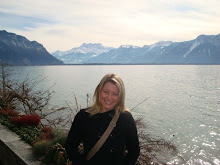
In addition to our daily classes, my school also organizes activities that we can sign up for on a fairly regular basis, but they're mostly weekend trips to visit castles by minibus (for the elderly who are too frail to ride a bike and who can't figure out the trains) or classes on wine (too expensive at 100 euros). The only one that caught my interest that I could afford was an offer to have a "cheese specialist" come to the school and give a educational class and tasting on the various types of cheese (10 euros). Yes, please.
So, that was how I came to find myself sitting around a table with 9 other students on the terrace of our school one sunny Wednesday afternoon, observing a Monsieur Marc Refarbert lay out a spread of fabulous looking cheeses. While I learned more than I can describe, there are three things I came to discover that stay at the top of my memory. First, that cheese was invented simply as a way to preserve milk so people could eat it later. Second, that contrary to popular opinion, white wine pairs better with cheese than red wine (or at least more often). And lastly, that while there are several hundred categories of cheese, there are 3 kinds of milk, 3 categories of texture, and 8 major families to make things a little easier.
Milk
1) Cow
2) Goat
3) Sheep
Texture
1) Frais (the most water)
2) Demi-sec (literally it means Half-dry)
3) Sec (dry, the least amount of water)
Families
1) Fromages frais (similar to yogurt or sour cream)
2) Fromages fondus (basically this just means "meltable" cheese)
3) Fromages de chevre (goat cheese)
4) Pâtes molles à croûte fleurie (this is brie and camembert - it means that when the cheese was made it was not subject to heat or pressing)
5) Pâtes pressées cuites (asiago, gruyere, parmesan - the cheese was subject to heat and pressing)
6) Pâtes pressées non cuites (edam or provologne - the cheese was pressed but was not heated)
7) Pâtes molles à croûte lavée (munster - the cheese underwent a washing process with warm salt water which created a stronger taste and the yellow color)
8) Pâtes persillées (bleu cheese or roquefort - means mold or penicillin was introduced in the cheese)
It's fascinating to know a little more about the cheese I eat, but really, it just tastes good.






No comments:
Post a Comment